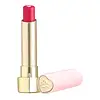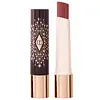What's inside
What's inside
 Key Ingredients
Key Ingredients

 Benefits
Benefits

 Concerns
Concerns

 Ingredients Side-by-side
Ingredients Side-by-side

Polyglyceryl-2 Triisostearate
EmulsifyingDiisostearyl Malate
EmollientHydrogenated Poly(C6-14 Olefin)
EmollientPolybutene
Pentaerythrityl Tetraisostearate
EmollientBis-Diglyceryl Polyacyladipate-2
EmollientPolyethylene
AbrasiveOctyldodecanol
EmollientSynthetic Fluorphlogopite
Synthetic Wax
AbrasiveMalpighia Glabra Fruit Extract
Skin ConditioningEuphorbia Cerifera Wax
Caprylic/Capric Triglyceride
MaskingIsohexadecane
EmollientButyrospermum Parkii Butter
Skin ConditioningSodium Hyaluronate
HumectantTripeptide-1
Skin ConditioningDisteardimonium Hectorite
StabilisingPropylene Carbonate
SolventEthylene/Propylene Copolymer
AbrasiveEthylene/Propylene/Styrene Copolymer
Butylene/Ethylene/Styrene Copolymer
Xanthan Gum
EmulsifyingPolyhydroxystearic Acid
EmulsifyingCaprylyl Glycol
EmollientHexylene Glycol
EmulsifyingParfum
MaskingPentaerythrityl Tetra-Di-T-Butyl Hydroxyhydrocinnamate
AntioxidantPhenoxyethanol
PreservativeCI 77891
Cosmetic ColorantCI 77491
Cosmetic ColorantCI 77492
Cosmetic ColorantCI 77499
Cosmetic ColorantCI 42090
Cosmetic ColorantCI 15850
Cosmetic ColorantCI 45410
Cosmetic ColorantCI 73360
Cosmetic ColorantCI 19140
Cosmetic ColorantPolyglyceryl-2 Triisostearate, Diisostearyl Malate, Hydrogenated Poly(C6-14 Olefin), Polybutene, Pentaerythrityl Tetraisostearate, Bis-Diglyceryl Polyacyladipate-2, Polyethylene, Octyldodecanol, Synthetic Fluorphlogopite, Synthetic Wax, Malpighia Glabra Fruit Extract, Euphorbia Cerifera Wax, Caprylic/Capric Triglyceride, Isohexadecane, Butyrospermum Parkii Butter, Sodium Hyaluronate, Tripeptide-1, Disteardimonium Hectorite, Propylene Carbonate, Ethylene/Propylene Copolymer, Ethylene/Propylene/Styrene Copolymer, Butylene/Ethylene/Styrene Copolymer, Xanthan Gum, Polyhydroxystearic Acid, Caprylyl Glycol, Hexylene Glycol, Parfum, Pentaerythrityl Tetra-Di-T-Butyl Hydroxyhydrocinnamate, Phenoxyethanol, CI 77891, CI 77491, CI 77492, CI 77499, CI 42090, CI 15850, CI 45410, CI 73360, CI 19140
Diisostearyl Malate
EmollientBis-Behenyl/Isostearyl/Phytosteryl Dimer Dilinoleyl Dimer Dilinoleate
EmollientBis-Diglyceryl Polyacyladipate-2
EmollientHydrogenated Polyisobutene
EmollientCeresin
Emulsion StabilisingOctyldodecanol
EmollientSynthetic Wax
AbrasivePentaerythrityl Tetraisostearate
Emollient1,2-Hexanediol
Skin ConditioningDisteardimonium Hectorite
StabilisingSodium Hyaluronate
HumectantPassiflora Edulis Seed Oil
EmollientTheobroma Grandiflorum Seed Butter
Skin ConditioningPalmitoyl Hexapeptide-12
Skin ConditioningParfum
MaskingTocopheryl Acetate
AntioxidantPropylene Carbonate
SolventCaprylic/Capric Triglyceride
MaskingC10-18 Triglycerides
EmollientTriolein
Skin ConditioningTriethoxycaprylylsilane
Stearalkonium Hectorite
Gel FormingGlyceryl Dioleate
EmollientCI 77891
Cosmetic ColorantIron Oxides
CI 15850
Cosmetic ColorantDiisostearyl Malate, Bis-Behenyl/Isostearyl/Phytosteryl Dimer Dilinoleyl Dimer Dilinoleate, Bis-Diglyceryl Polyacyladipate-2, Hydrogenated Polyisobutene, Ceresin, Octyldodecanol, Synthetic Wax, Pentaerythrityl Tetraisostearate, 1,2-Hexanediol, Disteardimonium Hectorite, Sodium Hyaluronate, Passiflora Edulis Seed Oil, Theobroma Grandiflorum Seed Butter, Palmitoyl Hexapeptide-12, Parfum, Tocopheryl Acetate, Propylene Carbonate, Caprylic/Capric Triglyceride, C10-18 Triglycerides, Triolein, Triethoxycaprylylsilane, Stearalkonium Hectorite, Glyceryl Dioleate, CI 77891, Iron Oxides, CI 15850
Ingredients Explained
These ingredients are found in both products.
Ingredients higher up in an ingredient list are typically present in a larger amount.
This ingredient is lipid-based synthetic skin-conditioning agent derived from adipic acid and a mixture of fatty acids. It is often called a lanolin substitute.
As an emollient, it helps soften and hydrate the skin. Emollients create a barrier on the skin to trap moisture in.
Due to its fatty acid base, it may not be Malassezia folliculitis safe.
Learn more about Bis-Diglyceryl Polyacyladipate-2This ingredient is an emollient, solvent, and texture enhancer. It is considered a skin-softener by helping the skin prevent moisture loss.
It helps thicken a product's formula and makes it easier to spread by dissolving clumping compounds.
Caprylic Triglyceride is made by combining glycerin with coconut oil, forming a clear liquid.
While there is an assumption Caprylic Triglyceride can clog pores due to it being derived from coconut oil, there is no research supporting this.
Learn more about Caprylic/Capric TriglycerideCi 15850 is the pigment color red. It is an azo dye and created synthetically.
Azo dyes need to be thoroughly purified before use. This allows them to be more stable and longer-lasting.
This ingredient is common in foundations, lipsticks, and blushes. This color is described as brown/orangey red.
It has many secondary names such as Red 6 and Red 7. According to a manufacturer, Red 6 usually contains aluminum.
Learn more about CI 15850Ci 77891 is a white pigment from Titanium dioxide. It is naturally found in minerals such as rutile and ilmenite.
It's main function is to add a white color to cosmetics. It can also be mixed with other colors to create different shades.
Ci 77891 is commonly found in sunscreens due to its ability to block UV rays.
Learn more about CI 77891Diisostearyl Malate is an emollient and most often used in lip products. It comes from isostearyl alcohol, a fatty acid, and malic acid, an AHA.
As an emollient, Diisostearyl Malate helps create a thin film on your skin to trap moisture in. This helps keep your skin soft and smooth.
Disteardimonium Hectorite comes from the clay mineral named hectorite. It is used to add thickness to a product.
It can also help stabilize a product by helping to disperse other ingredients.
Hectorite is a rare, white clay mineral.
Learn more about Disteardimonium HectoriteOctyldodecanol is a fatty alcohol. It is primarily used to enhance the texture of products.
As an emulsifier, Octyldodecanol helps prevent the oils and waters from separating. It also prevents ingredients from creating foam when shaken.
Octyldodecanol is created by reducing fatty acid to an alcohol.
Due to its high molecular weight, it does not get absorbed into the skin.
Learn more about OctyldodecanolParfum is a catch-all term for an ingredient or more that is used to give a scent to products.
Also called "fragrance", this ingredient can be a blend of hundreds of chemicals or plant oils. This means every product with "fragrance" or "parfum" in the ingredients list is a different mixture.
For instance, Habanolide is a proprietary trade name for a specific aroma chemical. When used as a fragrance ingredient in cosmetics, most aroma chemicals fall under the broad labeling category of “FRAGRANCE” or “PARFUM” according to EU and US regulations.
The term 'parfum' or 'fragrance' is not regulated in many countries. In many cases, it is up to the brand to define this term.
For instance, many brands choose to label themselves as "fragrance-free" because they are not using synthetic fragrances. However, their products may still contain ingredients such as essential oils that are considered a fragrance by INCI standards.
One example is Calendula flower extract. Calendula is an essential oil that still imparts a scent or 'fragrance'.
Depending on the blend, the ingredients in the mixture can cause allergies and sensitivities on the skin. Some ingredients that are known EU allergens include linalool and citronellol.
Parfum can also be used to mask or cover an unpleasant scent.
The bottom line is: not all fragrances/parfum/ingredients are created equally. If you are worried about fragrances, we recommend taking a closer look at an ingredient. And of course, we always recommend speaking with a professional.
Learn more about ParfumPentaerythrityl Tetraisostearate is derived from isostearic acid. It is an emollient and emulsifier.
The highest concentration of this ingredient is found in lipsticks.
This ingredient is minimally water soluble and may not be Malassezia folliculitis, or fungal-acne safe.
Learn more about Pentaerythrityl TetraisostearateThis ingredient is a solvent. It helps dissolve active ingredients and alter the texture of products.
Propylene Carbonate is commonly used in makeup and with clay, such as montmorillonite or bentonite.
Studies show this ingredient to be safe for cosmetics. When it is undiluted, it can cause skin irritation. (It is always diluted in skincare and makeup). This ingredient is water-soluble.
Propylene Carbonate is created from propylene glycol and carbonic acid.
Learn more about Propylene CarbonateSodium Hyaluronate is hyaluronic acid's salt form. It is commonly derived from the sodium salt of hyaluronic acid.
Like hyaluronic acid, it is great at holding water and acts as a humectant. This makes it a great skin hydrating ingredient.
Sodium Hyaluronate is naturally occurring in our bodies and is mostly found in eye fluid and joints.
These are some other common types of Hyaluronic Acid:
Learn more about Sodium HyaluronateSynthetic Wax is created from fossil fuels such as natural gas. It is used to enhance texture, adjust pH, and as an occlusive.
It may also be used as an abrasive ingredient to exfoliate the skin.
Synthetic Wax may not be fungal acne safe.
Learn more about Synthetic Wax